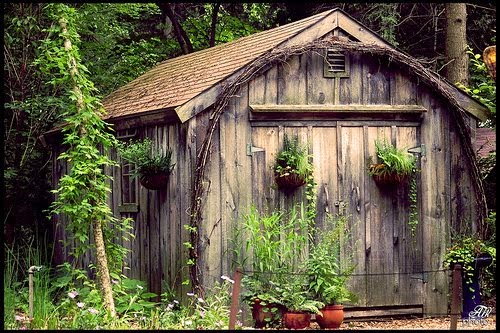 |
| FARM GIRL |
What's that Mac? I am? Do your really think so? Well that's kind of sweet in a way. Crude, unnecessary and off topic, but sweet!
At any rate, back to the ground that is available to be worked and how it further dictates where we'll place the garden. We already know where exposure to the sun is adequate, and that is our first limiting factor. Next we are going to want a plot or plots of land which are flat, close to water, preferably close to the house and or tool shed and which are easily fenced.
First of all, a garden does not have to be on flat land. Millions of tons of fine produce has been grown on hillsides, and even on some very steep slopes.
Thomas Jefferson's kitchen garden was and still is grown on a gentle hillside at Monticello, for example.
Gardeners young and old should tour Monticello, by the way, if only for the orchards and gardens!
Veggie gardens can be very attractive, and even very productive on steep slopes but they are labor intensive and probably expensive to build and maintain and difficult to work in compared to a flat plot. They are also subject to washout when a torrential rain comes along. If the option for a flatter surface is open to you, by all means take it.
Flower gardens, now, on a hillside can be simply spectacular!
 Most folks don't enjoy carrying water, which is heavy, and there is a limit to how many hoses you can string together. It is good to have when feasible a source of water close to the the garden. Usually this will also mean close to the house although as we will see this is more of a guideline than a rule.
Most folks don't enjoy carrying water, which is heavy, and there is a limit to how many hoses you can string together. It is good to have when feasible a source of water close to the the garden. Usually this will also mean close to the house although as we will see this is more of a guideline than a rule.If the garden is close by the back door, for example, it is then be easier to access the veggies and herbs at dinner time, and tools, insect sprays, and other necessities will also be close at hand. These are good things!
 |
| A NICELY LAID OUT GARDEN, SLOPED BUT NOT EXTREMELY SO, A WELL BUILT ATTRACTIVE FENCE (A TAD LOW TO EXCLUDE DEER) CLOSE BY THE HOUSE...WHAT'S NOT TO LIKE? |
Can you build a fence easily? Well, unless you happen to live somewhere where there are no deer, no bunnies, no woodchucks and all the rest of all those furry thieves you will need one. Usually, if you can put in a garden at all, then you can also put in a fence simply enough.
The impediment is usually only a man made one. Growing numbers of overly intrusive local governments have zoning ordinances dictating where and how a homeowner can erect a fence on his own property. No one wants to find out too late that the garden fence is two feet too tall and too close to the neighbors property line, so it is a good idea to check out the rules first.
Of course, if you get along with the neighbor this may not be as relevant but better to build a fence once than twice.
And there you have a few simple tips on how to best situate the new veggie patch. In part 3, coming soon, we'll go over the use and lay out of raised beds and various other design pointers for inside the wire.
Thanks for visiting Farm Girl's Corner!




1 comment:
Great post. I did so love The Jefferson gardens.
Post a Comment